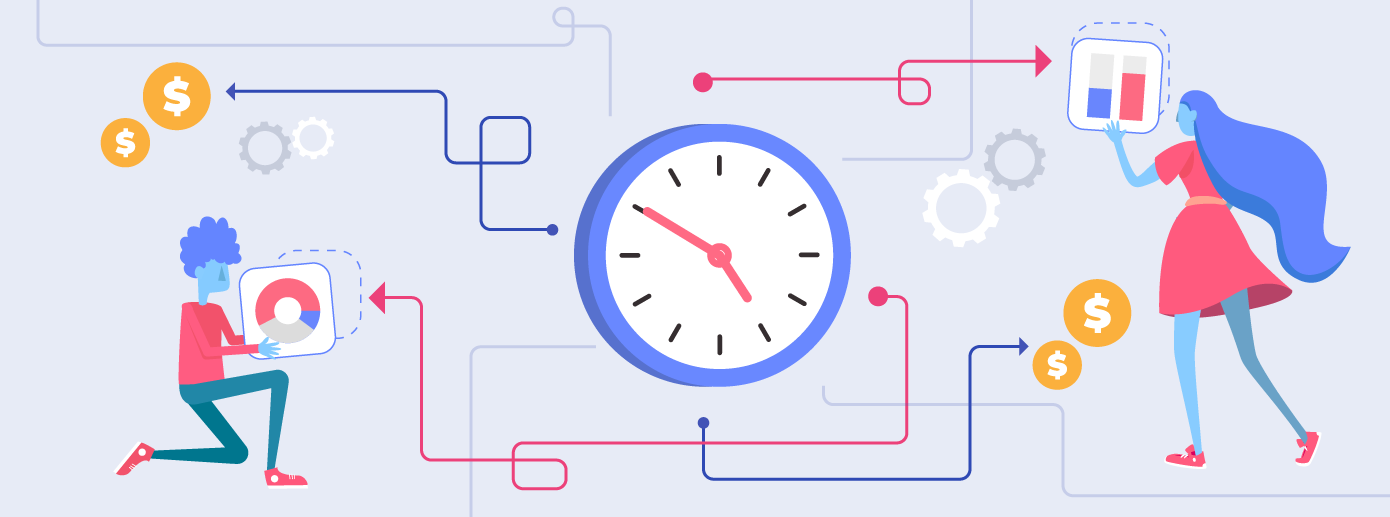
How to Monetize Data Analytics: A Guide for ISVs & SaaS Platforms
The fastest way to monetize your data is by embedding white-labeled dashboards directly into your product. While the opportunity is clear, the execution isn’t always easy. Building in-house drains time, money, and dev resources, and choosing the wrong partner can lead to the same bottlenecks that stall monetization efforts.
Executive Summary:
Data monetization isn’t optional anymore. It’s a proven path for SaaS platforms and ISVs to unlock new revenue, improve retention, and stand out in crowded markets. But launching dashboards isn’t the same as monetizing data.
Without the right strategy, even feature-rich dashboards fail to gain traction.
In this guide, we’ll walk through five proven monetization models, a step-by-step rollout strategy, and the common pitfalls that stall growth. You’ll learn how to monetize data analytics without draining your roadmap, exhausting your dev team, or burning cash.
Embedded analytics is the foundation. But how you monetize it is what determines success. The right approach depends on your product strategy, user behavior, and how your customers perceive value. Below, we break down five proven monetization models that real SaaS and ISV companies are using to turn data into revenue without compromising their core product.
Executive Summary
Monetizing data analytics isn’t just about adding dashboards. It’s about turning insights into a scalable, embedded revenue stream. For ISVs and SaaS platforms, embedded analytics offers the fastest path to drive new revenue, increase retention, and differentiate in competitive markets. But success depends on how you roll it out.
Key points:
- 5 Proven Monetization Models: Freemium, Tiered Pricing, Add-Ons, Pay-Per-Insight, and White-Labeled Analytics
- A Step-by-Step Strategy: From identifying valuable data to choosing the right model, driving adoption, ensuring compliance, and aligning your internal teams
- The Biggest Monetization Pitfalls: High dev costs, poor scalability, customization limits, unpredictable pricing, and weak adoption
- Why Embedded Analytics is the Key: Native, white-labeled, scalable analytics drive user trust and long-term revenue
Whether you’re launching analytics for the first time or looking to unlock more value from your current offering, this guide will help you design a data monetization strategy that delivers results fast.
5 Data Monetization Models That Turn Embedded Analytics into Revenue
To monetize analytics successfully, you need more than dashboards. You need a business model behind them. The right approach aligns with how your customers want to pay, use, and grow with your product.
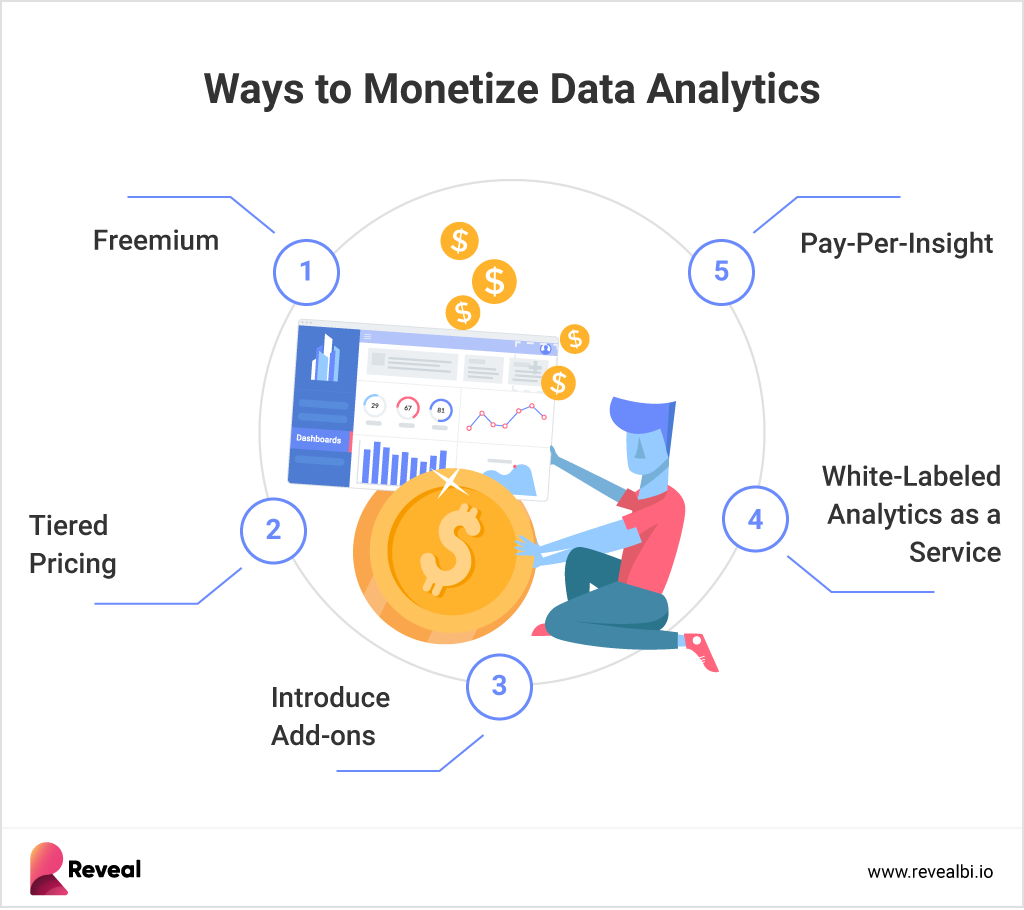
So, we’ve gathered the 5 proven ways ISV and SaaS companies can monetize analytics effectively.
Freemium
Give users a taste of your analytics then charge for real value. Freemium models let you prove ROI before asking for commitment, turning engagement into revenue without sales pressure. Hands-on access builds trust and drives upgrades without the need for demos or onboarding roadblocks.
You can gate features like:
- Self-service dashboard creation
- AI predictive analytics and trend forecasting
- Advanced filtering and drill-down
- Data export of sharing capabilities
Why it works:
- Reduces time to value—users experience ROI before they pay
- Creates natural upgrade triggers as usage deepens
- Converts usage into revenue without high-pressure selling
Perfect for:
SaaS platforms looking to increase user acquisition while planting upsell opportunities over time.
Tiered Pricing
Tiered pricing lets you scale your data monetization strategy across customer segments, aligning advanced analytics features with your existing product plans. It’s a flexible way to monetize data analytics without overcomplicating your packaging.
Start with static dashboards in entry-level plans and unlock high-value features, such as custom dashboards, AI-powered forecasting, and API access, as customers progress to higher plans.
You can split access along these lines:
- Starter: View-only, prebuilt dashboards
- Pro: Editable dashboards, advanced filters, alerting
- Enterprise: Full white-label control, API integration, predictive analytics
Why it works:
- Increases average revenue per user (ARPU) by tying real features to real value
- Drives upgrades by mapping analytics depth to customer maturity
- Keeps pricing aligned with usage, not just headcount
Perfect for:
ISVs and SaaS platforms with clear product tiers and a diverse customer base at different levels of data maturity—making it one of the most effective data monetization strategies for modern software.
Introduce Add-ons
Add-ons are a simple, scalable way to monetize analytics without disrupting your core pricing model. Instead of raising prices across the board, you keep your base product lean. The customers pay only for the advanced data capabilities they actually use.
You can offer analytics as:
- An insights bundle for $X/month
- A compliance reporting module
- A white-label dashboard toolkit
- A data export toolset
Why it works:
- Adds flexible, high-margin revenue without impacting base pricing
- Keeps entry-level pricing low for non-analytic users
- Allows you to test and refine your data monetization strategy over time
Perfect for:
SaaS vendors with modular pricing models or customers in regulated industries who need reporting but don’t want to pay for full analytics upfront.
Pay-Per-Insight
Pay-per-insight turns analytics into a revenue stream without subscriptions or feature gating. Customers pay only when they need a report, export, or forecast. It’s analytics as a service, not a locked-in plan. It’s a way to monetize analytics without bloating your pricing or forcing unused features into paid plans.
Think of it as analytics on demand—users get value when they need it, and you get paid every time they do.
You can charge for things like:
- Full report exports (PDF, Excel)
- One-click trend forecasting
- Threshold-based data access (e.g. after 100 rows)
- On-demand simulations and what-if models
Why it works:
- Unlocks transactional revenue
- Delivers value without plan changes
- Perfect for low-frequency, high-value use cases
Perfect for:
Perfect for SaaS vendors in healthcare, finance, or logistics, where on-demand reporting supports a flexible data monetization strategy without committing users to a full plan.,
White-Labeled Analytics as a Service
Let customers brand your analytics as their own. With white-labeling, you provide the engine, they control the visuals. It’s their logo, their colors, their domain, but your infrastructure.
You can charge for:
- White-label activation per tenant
- Custom branding options (logos, themes, colors)
- Branded exports (PDF, PPT, Excel)
- Embedding analytics under a customer’s domain
Why it works:
- Increases perceived value with minimal effort
- Enables your customers to showcase insights as their own
- Justifies premium pricing for enterprise or reseller use
Perfect for:
Enterprise and agency environments where brand control is essential, making white-labeling one of the most effective ways to monetize data analytics.
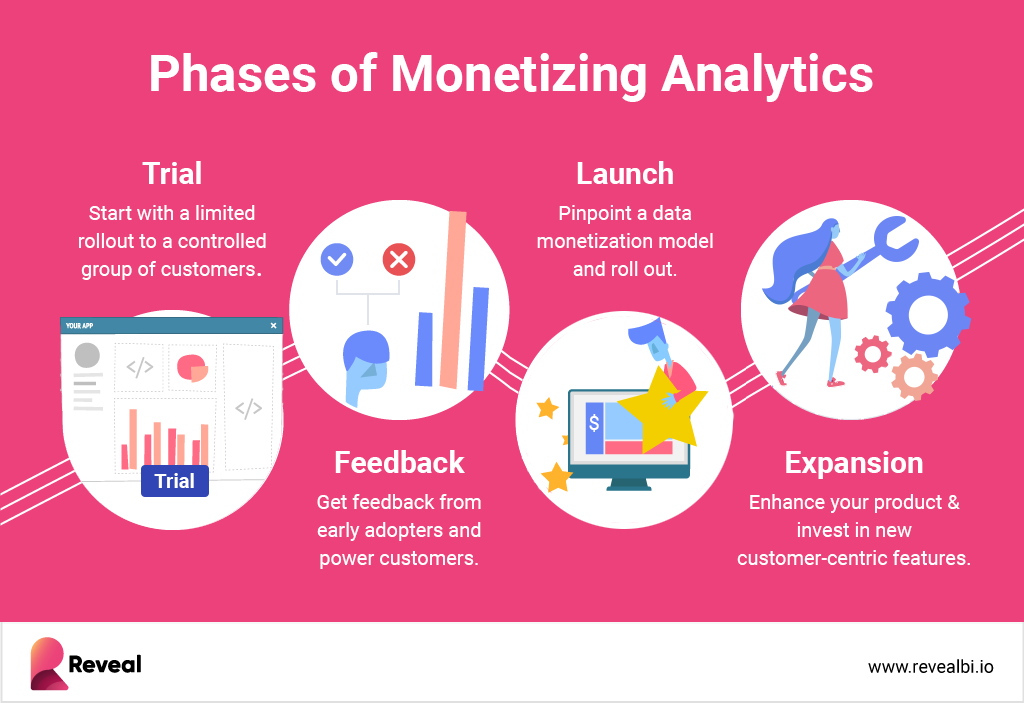
Building a Data Monetization Strategy
Introducing analytics features to your product is not enough to generate revenue. Why? Users won’t pay for features they don’t value or use even if you implement a suitable data monetization plan. A real data monetization strategy starts with one question: “What’s valuable enough for users to pay for again and again?” If you can’t answer that, no pricing model will save you.
Let’s break down what it takes to build a scalable, product-first data monetization strategy.
Step 1: Know Which Insights Have Revenue Potential
Not all data is monetizable. Customers pay for insights that solve real problems, not just raw numbers.
For example, combining predictive delivery insights with live tracking data can help logistics and retail companies cut shipment delays. That kind of insight doesn’t just inform, it saves money and drives action. It’s exactly the kind of value customers will pay for.

With this in mind, make sure to invest in an analytics solution that offers low-code/no-code development tools, so you can use the opportunity to monetize your data analytics offering.
Recommended Actions:
- Data Inventory: Audit the data you collect, generate, and track across your platform.
- Problem Alignment: Map your data to the key challenges your customers need to solve.
- Insight Prioritization: Focus on high-impact, high-demand insights with clear business value.
Step 2: Match the Right Monetization Model to Your Product
Choose the wrong data monetization model, and you’ll stall adoption, confuse your users, or miss out on meaningful revenue opportunities. The right model will match how your customers use your platform and how they’re willing to pay for insight.
For example, a SaaS company specializing in healthcare-related products can utilize the pay-per-insight model, as their customers need reports only periodically. Thus, it’s way more convenient for them to pay per report than a subscription fee. Moreover, this method will be more aligned with the hospital billing practices.

Recommended Actions:
- Behavior-Based Pricing: Align your pricing model with how users interact with your product, not just feature availability.
- Controlled Rollouts: Test new models with a targeted user segment before scaling.
- A/B Testing: Measure adoption and revenue impact across variations.
- Data-Driven Adjustments: Refine your approach based on user feedback and conversion data.
Step 3: Design for the End-User
Even advanced analytics features fail if they feel bolted on. Users expect embedded analytics to match the look and feel of your product and work like it belongs there. Analytics must be intuitive, fast, and fully integrated into your app’s UX. Embedded, white-label analytics convey better security and increase adoption.
Fintech users aren’t going to trust a pop-up analytics widget with their portfolio data. But when your embedded analytics solution feels like part of the app, they treat it like any other secure feature.
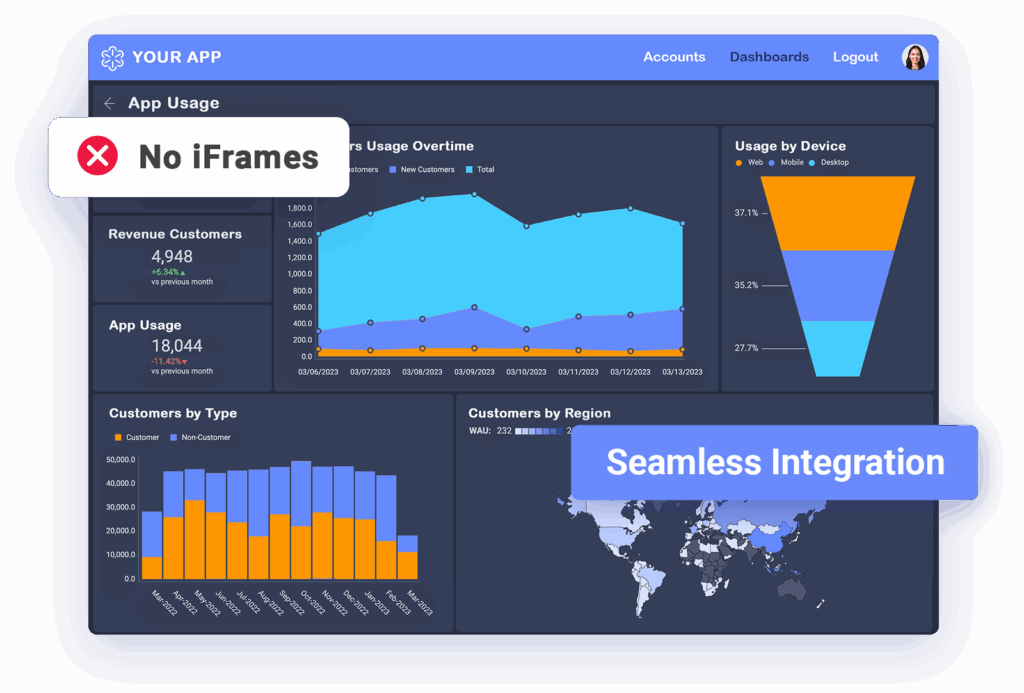
Recommended Actions:
- Native Integration: Embed analytics directly into your app without using iFrames.
- Branded Dashboards: Match theming, layout, and visuals to your product’s UI.
- Self-Service Tools: Enable drag-and-drop dashboard creation for end users.
Step 4: Turn Compliance into a Competitive Advantage
No matter how powerful your analytics are, poor governance will kill trust, break compliance, and lose enterprise deals. You don’t need to violate a federal mandate to lose customers. Miss their internal security standards, and they’ll drop you without hesitation.
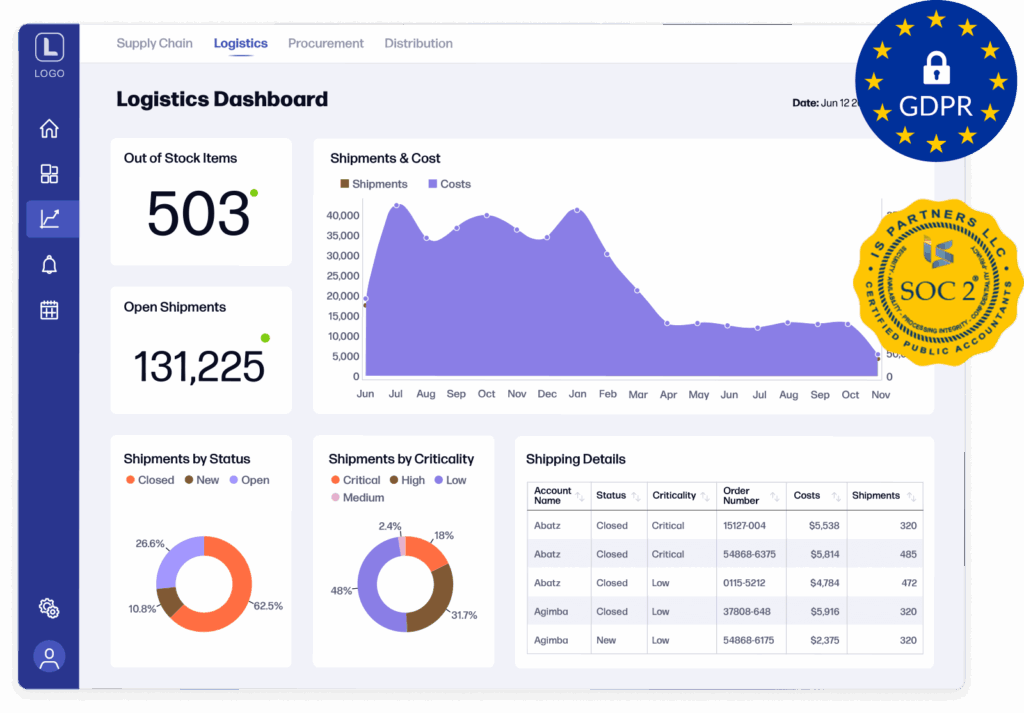
Recommended Actions:
- Secure Architecture: Implement multi-tenant infrastructure with strict role-based access controls.
- Regulatory Compliance: Meet GDPR, CCPA, and HIPAA standards within your analytics environment.
- Built-In Governance: Use a solution with native data governance features to simplify security and compliance.
Step 5: Don’t Let Performance Kill Monetization
Slow, unreliable dashboards kill adoption and, subsequently, kill revenue. Your dashboards might be beautiful, but if they lag under real usage, they won’t get used. Scaling is not just about adding new users. It is about keeping performance strong as data volume, queries, and use cases grow across your entire user base.
Using a flexible, built-for-scaling embedded analytics solution ensures you can meet the expanding needs of both current and new users. Thus, you will be able to expand your revenue.
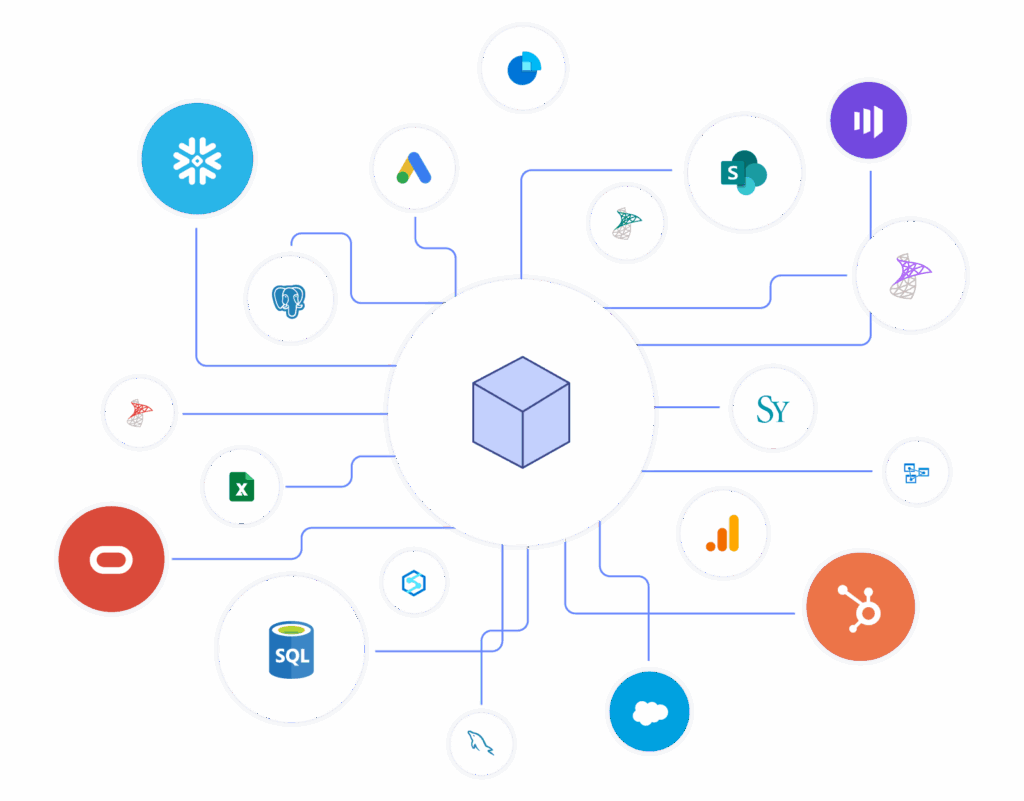
Recommended Actions:
- Scalable Architecture: Select a platform that supports both in-memory and query-based scaling.
- Real-World Testing: Evaluate performance under actual usage conditions, not just demo scenarios.
- Predictable Costs: Work with a provider that offers fixed pricing, regardless of usage or growth.
- Sustained Performance: Use architecture designed to keep dashboards fast and responsive as your user base expands.
Step 6: Internal Alignment
To be able to monetize analytics, your internal team should be able to promote and sell it. Thus, you need an internal alignment on what to advertise, the capabilities, the customer pain points, and how your analytics will solve their problem.

Recommended Actions:
- Team Training: Educate customer-facing teams on the value and capabilities of your analytics offering.
- Sales Enablement: Equip teams with resources like demo scripts, FAQs, and use-case guides.
- Simplicity by Design: Leverage intuitive UI and easy-to-demo dashboards to support alignment and education.
Final Tip: Start Simple
Complicated monetization schemes will only confuse your users and stall adoption. Simplicity drives faster validation and quicker revenue wins.
For example, if a SaaS platform launches a freemium analytics solution that clearly tells what is free and what is paid, it will generate significantly more revenue than creating a complicated payment scheme based on usage, hidden costs, and computing power.
Customers want clear pricing they can plan and budget for, and confusion only leads to lost revenue.
Recommended Actions:
- Clear Launch Strategy: Start with a single monetization model linked to a measurable outcome.
- Adoption First: Prioritize user adoption to validate product-market fit and pricing.
- Scale with Proof: Expand only after confirming success through real usage and results.
Problems with Monetizing Analytics
Monetizing analytics seems simple at first, but most SaaS and ISVs face hidden risks that drain resources, slow growth, and cripple ROI. Without the right approach, analytics projects turn into expensive liabilities instead of profitable features.
Let’s examine the 5 biggest challenges ISVs and SaaS companies face when monetizing analytics.
High development cost
Building analytics in-house almost always costs more and takes longer than expected. What often begins as a simple dashboard feature turns into months of additional development, budget overruns, and heavy maintenance demands. This pulls valuable resources away from your core product, delays feature rollouts, and damages your competitive speed.
How to Mitigate:
- Carefully estimate total costs across build, maintenance, and support phases.
- Prioritize buying embedded analytics solutions unless analytics is your primary product focus.
- Allocate dedicated resources to ongoing updates if choosing an internal build path.
Scalability Issues
Analytics solutions built for small datasets often collapse under real-world load. As your users grow and data volumes expand, slow dashboards, delayed queries, and inconsistent performance quickly erode trust and usage. When analytics slow down, users drop off, and support queues spike.
How to Mitigate:
- Find an embedded analytics solution built for scaling
- Stress-test your analytics platform with real-world data sizes and user concurrency before full rollout.
- Design your architecture with in-memory capabilities or distributed data handling for scaling.
- Continuously monitor load times and usage metrics to spot early warning signs.
Lack of Customization
Analytics that don’t match your application’s look and feel break the user experience. Disjointed dashboards break user trust and kill upgrade potential. If it doesn’t feel like part of your product, users won’t see it as something worth using.
How to Mitigate:
- Ensure full white-labeling capabilities, including theming, logos, fonts, and UI alignment.
- Embed analytics natively into your app, avoiding iFrame-based shortcuts.
- Allow end-users to personalize dashboards for their specific needs.
Unpredictable Pricing Models
Many embedded analytics platforms charge by user, sessions, or API calls. As adoption grows, so do your costs—this creates budgeting nightmares, margin erosion, and unpredictable profitability. This undermines your monetization strategy as a whole. Scaling successfully becomes harder when your own success inflates your operational costs.
How to Mitigate:
- Choose embedded analytics solutions with simple, fixed pricing models.
- Forecast future user growth scenarios to evaluate long-term platform costs.
- Align your monetization strategy to revenue streams that aren’t capped by rising usage fees.
User Adoption Hesitation
Even if analytics are technically powerful, users won’t adopt them if they feel clunky, slow, or disconnected from the app. Poor UX drives disengagement and undercuts the revenue potential of your monetized analytics features. Without strong adoption, upselling analytics becomes nearly impossible.
How to Mitigate:
- Embed analytics directly into the app’s core experience—avoid iFrame or external redirects.
- Match the analytics UX/UI exactly to the rest of your product.
- Prioritize fast load times, clean navigation, and intuitive self-service functionality.
Start Monetizing Analytics with Reveal
Monetizing analytics is not a feature; it is a business model that works only when insights are built into your product, pricing, and user experience from the start. Disconnected dashboards and framed add-ons are not strategies—they create friction and weaken adoption, engagement, and growth.
Reveal solves this by making data part of your core product—seamless, on-brand, and built to scale.
With embedded analytics, you can:
- Ship faster: Skip the 12-month build cycle and launch in weeks, not quarters.
- Drive adoption: Deliver a native experience that feels like a natural extension of your app.
- Scale without surprises: Choose an embedded analytics provider with fixed pricing that grows with you, not against you.
- Monetize your way: Create freemium upgrades, tiered analytics plans, or pay-per-insight models that match your customers’ real needs, without changing your core app.
Reveal turns your analytics into more than a feature. It becomes a native, branded revenue stream inside your product.


 Return to Blog
Return to Blog
